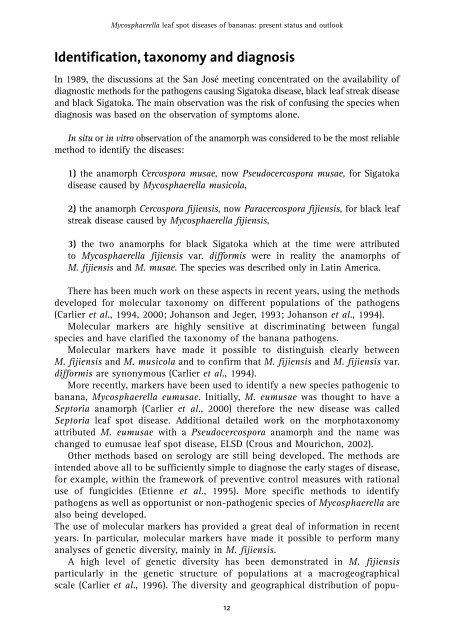Mycosphaerella leaf spot diseases of bananas - CBS
Mycosphaerella leaf spot diseases of bananas - CBS
Mycosphaerella leaf spot diseases of bananas - CBS
Create successful ePaper yourself
Turn your PDF publications into a flip-book with our unique Google optimized e-Paper software.
<strong>Mycosphaerella</strong> <strong>leaf</strong> <strong>spot</strong> <strong>diseases</strong> <strong>of</strong> <strong>bananas</strong>: present status and outlook<br />
Identification, taxonomy and diagnosis<br />
In 1989, the discussions at the San José meeting concentrated on the availability <strong>of</strong><br />
diagnostic methods for the pathogens causing Sigatoka disease, black <strong>leaf</strong> streak disease<br />
and black Sigatoka. The main observation was the risk <strong>of</strong> confusing the species when<br />
diagnosis was based on the observation <strong>of</strong> symptoms alone.<br />
In situ or in vitro observation <strong>of</strong> the anamorph was considered to be the most reliable<br />
method to identify the <strong>diseases</strong>:<br />
1) the anamorph Cercospora musae, now Pseudocercospora musae, for Sigatoka<br />
disease caused by <strong>Mycosphaerella</strong> musicola,<br />
2) the anamorph Cercospora fijiensis, now Paracercospora fijiensis, for black <strong>leaf</strong><br />
streak disease caused by <strong>Mycosphaerella</strong> fijiensis,<br />
3) the two anamorphs for black Sigatoka which at the time were attributed<br />
to <strong>Mycosphaerella</strong> fijiensis var. difformis were in reality the anamorphs <strong>of</strong><br />
M. fijiensis and M. musae. The species was described only in Latin America.<br />
There has been much work on these aspects in recent years, using the methods<br />
developed for molecular taxonomy on different populations <strong>of</strong> the pathogens<br />
(Carlier et al., 1994, 2000; Johanson and Jeger, 1993; Johanson et al., 1994).<br />
Molecular markers are highly sensitive at discriminating between fungal<br />
species and have clarified the taxonomy <strong>of</strong> the banana pathogens.<br />
Molecular markers have made it possible to distinguish clearly between<br />
M. fijiensis and M. musicola and to confirm that M. fijiensis and M. fijiensis var.<br />
difformis are synonymous (Carlier et al., 1994).<br />
More recently, markers have been used to identify a new species pathogenic to<br />
banana, <strong>Mycosphaerella</strong> eumusae. Initially, M. eumusae was thought to have a<br />
Septoria anamorph (Carlier et al., 2000) therefore the new disease was called<br />
Septoria <strong>leaf</strong> <strong>spot</strong> disease. Additional detailed work on the morphotaxonomy<br />
attributed M. eumusae with a Pseudocercospora anamorph and the name was<br />
changed to eumusae <strong>leaf</strong> <strong>spot</strong> disease, ELSD (Crous and Mourichon, 2002).<br />
Other methods based on serology are still being developed. The methods are<br />
intended above all to be sufficiently simple to diagnose the early stages <strong>of</strong> disease,<br />
for example, within the framework <strong>of</strong> preventive control measures with rational<br />
use <strong>of</strong> fungicides (Etienne et al., 1995). More specific methods to identify<br />
pathogens as well as opportunist or non-pathogenic species <strong>of</strong> <strong>Mycosphaerella</strong> are<br />
also being developed.<br />
The use <strong>of</strong> molecular markers has provided a great deal <strong>of</strong> information in recent<br />
years. In particular, molecular markers have made it possible to perform many<br />
analyses <strong>of</strong> genetic diversity, mainly in M. fijiensis.<br />
A high level <strong>of</strong> genetic diversity has been demonstrated in M. fijiensis<br />
particularly in the genetic structure <strong>of</strong> populations at a macrogeographical<br />
scale (Carlier et al., 1996). The diversity and geographical distribution <strong>of</strong> popu-<br />
12

















